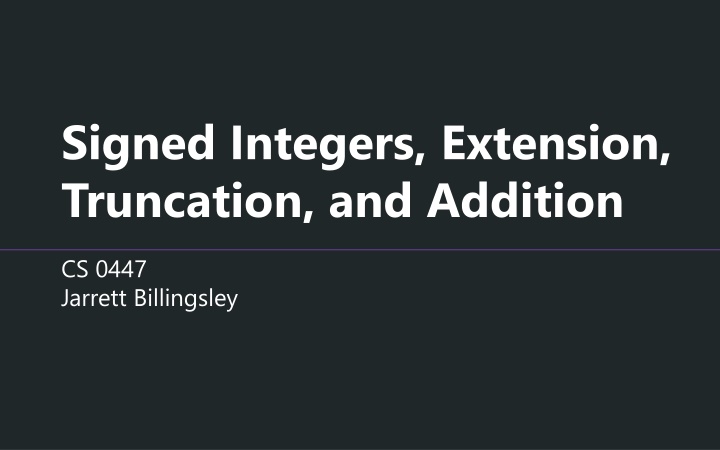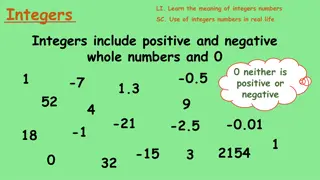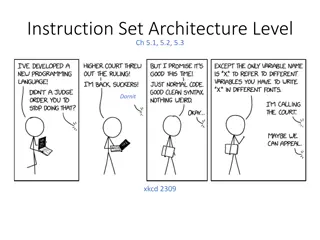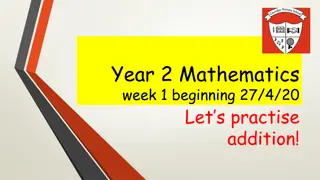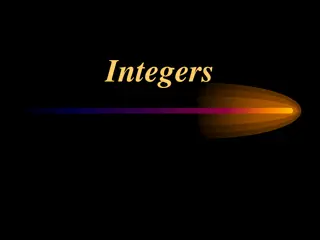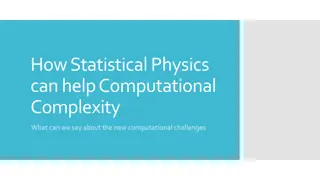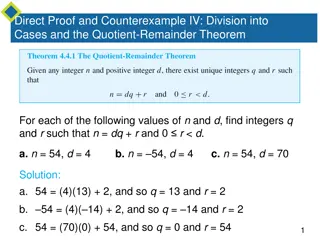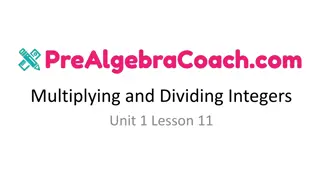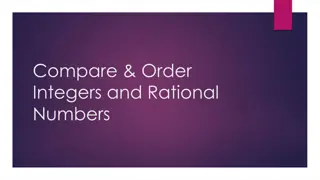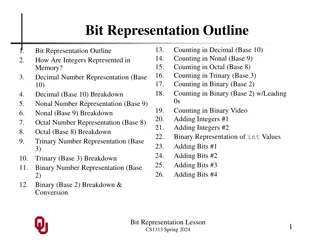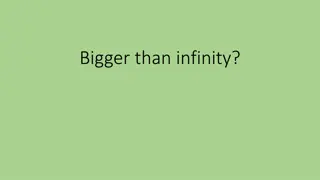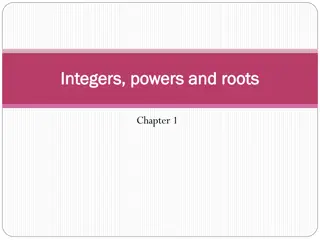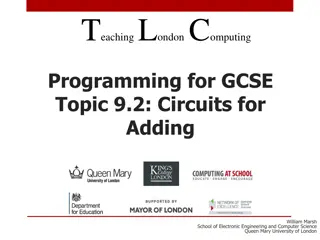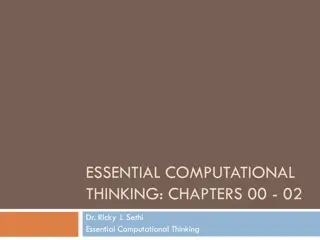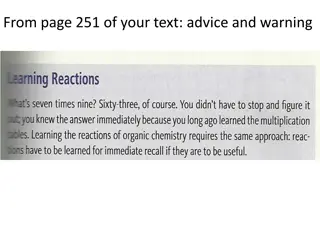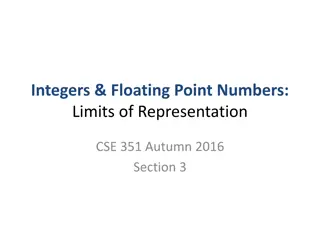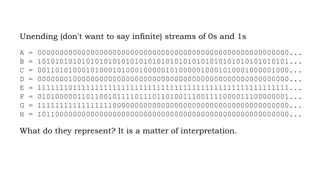Signed Integers and Addition in Computational Systems
Dive into the world of signed integers, extensions, truncations, and addition in computer science with a focus on how negative values are represented and operated on. Explore concepts like sign-magnitude and two's complement representations, uncovering the intricacies of handling integers in computational systems. Gain insights into the design choices that enable efficient arithmetic operations in binary systems.
Uploaded on Apr 06, 2024 | 5 Views
Download Presentation

Please find below an Image/Link to download the presentation.
The content on the website is provided AS IS for your information and personal use only. It may not be sold, licensed, or shared on other websites without obtaining consent from the author.If you encounter any issues during the download, it is possible that the publisher has removed the file from their server.
You are allowed to download the files provided on this website for personal or commercial use, subject to the condition that they are used lawfully. All files are the property of their respective owners.
The content on the website is provided AS IS for your information and personal use only. It may not be sold, licensed, or shared on other websites without obtaining consent from the author.
E N D
Presentation Transcript
Signed Integers, Extension, Truncation, and Addition CS 0447 Jarrett Billingsley
Class announcements last day to add the class is this Friday 1/19 (but the waitlists are so long) CS447 2
Signed Integers CS447 3
The basic idea if we want to have negatives, we need to come up with rules which o treat some bit patterns as negative values o allow us to do arithmetic correctly like a number and its negative should add up to 0 where's the sign written in math? +45 -19 how could we represent a sign in binary? + - 0101 1000 the sign bit is always the MSB NOT "the first 1 bit" how many signs are there? for these slides I'm using 4-bit numbers to save space, but you always have to know how many bits the number is to know which is the MSB CS447 4
Sign-magnitude? (this is not used for integers omg) this leads us to an intuitive but suboptimal representation: the bits after the sign bit are the distance from 0(aka magnitude) 1110 1100 1010 0000 0010 0100 0110 1111 1101 1011 1001 0001 0011 0101 0111 -7 negating is easy in S-M: just flip the sign bit. -6 -5 -4 -3 -2 -1 0 +1 +2 but what about 1000? what is its distance from 0? +3 +4 +5 +6 +7 1000 big problem: we have TWO ZEROES! +0 and -0 arithmetic on S-M is also kinda difficult. sign-magnitude is still used for floats. but not for integers. CS447 5
Two's complement for signed integers, we use two's complement. here's the idea: MSB (sign) 1001 0110 -128s 64s 32s 16s 8s 4s 2s 1s you can think of the MSB as having a negative value. so what number does this represent? when we say "signed integer", we mean 2's complement. it is the only signed integer representation in widespread use today. CS447 6
A weird number line let's see the bit patterns for negatives in 2's complement. 1000 1010 1100 1110 0000 0010 0100 0110 1001 1011 1101 1111 0001 0011 0101 0111 -8 -7 -6 -5 -4 -3 -2 -1 0 +1 +2 +3 +4 +5 +6 +7 but wait, what about 1000? now we only have one zero, and it's all 0 bits (whew) but the tradeoff is that the number line is lopsided. we have one more negative than positives. also how are we even getting the negative numbers from the positive numbers?? CS447 7
A negative number with no positive counterpart in 2's complement, to negate, you flip all the bits (0s become 1s and 1s become 0s), then add one. o (the number you get from this is also called the two s complement of the original number.) o let's negate +1 (0001) to see, then negate that to get back. but what do we get if we negate -8 (1000)? 1 1 1 0111 +0001 0 1 1000 you just add the sign bit like a normal place. FLIP 0 0 we negated -8 and got -8. that s weird. CS447 8
The signed number tradeoff if you have signed numbers, why would you want unsigned ones? well, let s look at the number lines for 4-bit unsigned and signed ints. 0 ... 7 8 ... 15 -8 0 +7 there is the same number of numbers on both (24 = 16). signed numbers present a tradeoff. you get to represent negative numbers at the expense of losing half the range on the positive side of the number line! CS447 9
Range of unsigned vs. signed numbers how many different values can you represent with n bits? o 2n and what are the smallest and the biggest? o 0 to 2n-1 for unsigned integers. well, for signed numbers, the range is -2n-1 to 2n-1-1 that feels kinda awkward, so let's get some intuition in 2 s complement, half of the bit patterns are assigned negative values. 0 ... 7 8 ... 15 -8 0 +7 so if you know the unsigned range, chop it in half. 8 bits unsigned= 0 to 255, so 8 bits signed is -128 to +127. CS447 10
Extension and Truncation CS447 11
Changing the number of bits integers on computers have a fixed number of bits. but what happens in this situation? byte b = 10; // 8 bits int i = b; // 32 bits you would (reasonably) expect that i == 10, and sure enough it does. o but how does that happen? how did we go from 8 bits to 32? also what happens in the other direction? int i = 20; byte b = i; // error: possible lossy conversion the compiler complains about this, so we have to write byte b = (byte)i; // ok! why? CS447 12
Zero extension let s start with unsigned numbers. you can always put 0s before a number so-called leading 0s without changing its value. that doesn t change the value. all I said is there are 0 16s. 10012 = 910 010012 = 910 if I now put a 0 in front in fact, I can add as many 0s to the front as I want! 10012 this is called zero-extension. it allows you to expand unsigned numbers to larger numbers of bits without changing their value. = 010012 = 0010012 = 00010012 = 000010012 = 910 etc CS447 13
But that doesnt work for signed numbers. signed numbers are a bit trickier, because the MSB is special. that seemed to work, but notice how the sign bit moved? 01112 = +710 what happens if I try to do it to a negative number? 001112 = +710 if I now put a 0 in front 10012 = -710 010012 = +910 if I now put a 0 in front uhhhhh what zero extension does not work for signed integers. CS447 14
Sign extension (animated) because the MSB of signed integers has a special meaning, we have to do different thingsdepending on whether it s a 1 or a 0. sign extension puts copies of the sign bit before the number. 10012 (-710) to 5 bits 110012 (-710) 01112 (+710) to 5 bits 001112(+710) I like to think of it like spreading peanut butter why does this work? consider 10012. the MSB is -8. if I put a 1 before it, the MSB is now -16, and the next lower place is 8. -16+8 = -8, the same as what we started with, so the value remains unchanged. 111111111111 1011 CS447 15
Truncation truncate means to cut short, and for our purposes it means cutting off bits on the left side of a number. if I truncate this unsigned integer to 4 bits, I get but if I keep going, strange things happen. the value was preserved, cause I just cut off leading 0s. 10012 = 910 000010012 = 910 I cut off a 1, and now I ended up with a different value! thisis what the Java compiler means about possible lossy conversion : sometimes, losing bits can change the value! 0012 = 110 for signed integers, you can get even weirder results. 10012 = -710 0012 = +110 CS447 16
Truncation and modular arithmetic let s see what happens if we truncate 4-bit unsigned ints to 2 bits. Original Truncated the value you get after truncation to n bits is not arbitrary. it is the 00002 = 010 00012 = 110 00102 = 210 00112 = 310 01002 = 410 01012 = 510 01102 = 610 01112 = 710 10002 = 810 10012 = 910 002 = 010 012 = 110 102 = 210 112 = 310 002 = 010 012 = 110 102 = 210 112 = 310 002 = 010 012 = 110 original number modulo 2n! here, n = 2, so the truncated values are the original numbers modulo 22 = 4. remember when we tried to do unsigned 11112 + 00012? what happens if we truncate the result to 4 bits? CS447 17
Integers arent on a line, theyre on a circle! because of this behavior, integers wrap around, like on a clock. the same positions are represented by the same bit patterns signed integers: unsigned integers: 0 0 15 -1 1 1 14 -2 2 2 13 -3 3 3 12 -4 4 4 but the meanings are different. 11 -5 5 5 6 6 10 -6 9 -7 7 7 8 -8 adding goes clockwise; subtracting goes counterclockwise. what is 14 + 5? what is -2 + 5? CS447 18
Addition and subtraction CS447 19
Two's complement addition the whole reason two s complement is so useful is that addition is dead simple. you can add any pair of two s complement numbers using the same procedure as we learned for unsigned numbers. Unsigned Signed 1 1 to binary? bit pattern for -6 is -8+2 0011 0011 3 3 +10 13 +-6 -3 +1010 +1010 1101 8 + 4 + 1 is 1101 -8 + 4 + 1 is it Just Works . the actual patterns of bits are the same. so how does a computer "know" whether it's doing signed or unsigned addition? CS447 20
IT DOESN'T CS447 21
It's up to you! the computer only knows one way to add numbers together. the meaning or interpretation of the inputs and output of the addition are decided by you, the programmer. in languages where you have signed and unsigned integers (e.g. C), you make this decision by choosing the type of the variable: int x = -5; unsigned int y = 20; o when these variables are printed, added, subtracted etc. they will be interpreted as signed or unsigned accordingly. CS447 22
Subtraction is subtraction really that different from addition? o x - y == x + -y o and in two's complement, -y == flip(y) + 1, so x - y == x + (flip(y) + 1) assuming 4- bit numbers 1 1 0111 +1100 0 0 7 7 -4 3 +12 = 1 1 3 this is typically how computers do it, since we can reuse the same circuit for both addition and subtraction. there s a carry out from the MSB, but because the result is truncatedback to 4 bits, it s thrown out. CS447 23
What is twos complement doing, anyway? on the previous slide, we saw that in 4-bit arithmetic: o the two s complement of 4 is 12, and o adding 12 behaves the same way as subtracting 4. why? it all comes back to the number circle. if we start at 7, we can subtract 4 by going counterclockwise 0 15 1 14 2 13 3 but because it s a circle, there are two ways around it. we can also go clockwise by 12, which is the two s complement of 4! 12 4 11 5 6 10 a number s two s complement behaves like its negative under modular arithmetic. 9 7 8 CS447 24
Comparison with subtraction subtraction is also how we compare numbers. if we do a - b, for any a and b If then a - b will be positive (>0) negative (<0) zero a > b a < b a == b how can you quickly see if an integer is negative? also, does this remind you of a certain Java method for comparing things ? CS447 25
